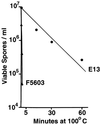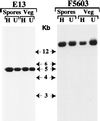Comparative experiments to examine the effects of heating on vegetative cells and spores of Clostridium perfringens isolates carrying plasmid genes versus chromosomal enterotoxin genes
- PMID: 10919775
- PMCID: PMC92139
- DOI: 10.1128/AEM.66.8.3234-3240.2000
Comparative experiments to examine the effects of heating on vegetative cells and spores of Clostridium perfringens isolates carrying plasmid genes versus chromosomal enterotoxin genes
Retraction in
-
Retraction for Sarker et al., "Comparative Experiments To Examine the Effects of Heating on Vegetative Cells and Spores of Clostridium perfringens Isolates Carrying Plasmid Genes versus Chromosomal Enterotoxin Genes".Appl Environ Microbiol. 2024 May 21;90(5):e0024924. doi: 10.1128/aem.00249-24. Epub 2024 Apr 12. Appl Environ Microbiol. 2024. PMID: 38606961 Free PMC article. No abstract available.
Abstract
Clostridium perfringens enterotoxin (CPE) is an important virulence factor for both C. perfringens type A food poisoning and several non-food-borne human gastrointestinal diseases. Recent studies have indicated that C. perfringens isolates associated with food poisoning carry a chromosomal cpe gene, while non-food-borne human gastrointestinal disease isolates carry a plasmid cpe gene. However, no explanation has been provided for the strong associations between certain cpe genotypes and particular CPE-associated diseases. Since C. perfringens food poisoning usually involves cooked meat products, we hypothesized that chromosomal cpe isolates are so strongly associated with food poisoning because (i) they are more heat resistant than plasmid cpe isolates, (ii) heating induces loss of the cpe plasmid, or (iii) heating induces migration of the plasmid cpe gene to the chromosome. When we tested these hypotheses, vegetative cells of chromosomal cpe isolates were found to exhibit, on average approximately twofold-higher decimal reduction values (D values) at 55 degrees C than vegetative cells of plasmid cpe isolates exhibited. Furthermore, the spores of chromosomal cpe isolates had, on average, approximately 60-fold-higher D values at 100 degrees C than the spores of plasmid cpe isolates had. Southern hybridization and CPE Western blot analyses demonstrated that all survivors of heating retained their cpe gene in its original plasmid or chromosomal location and could still express CPE. These results suggest that chromosomal cpe isolates are strongly associated with food poisoning, at least in part, because their cells and spores possess a high degree of heat resistance, which should enhance their survival in incompletely cooked or inadequately warmed foods.
Figures





References
-
- Ando Y, Tsuzuki T, Sunagawa H, Oka S. Heat resistance, spore germination, and enterotoxigenicity of Clostridium perfringens. Microbiol Immunol. 1985;29:317–326. - PubMed
-
- Bean N H, Goulding J S, Lao C, Angulo F J. Surveillance for foodborne-disease outbreaks—United States, 1988–1982. Morb Mortal Wkly Rep. 1996;45:1–54. - PubMed
-
- Bean N H, Griffen P M. Foodborne disease outbreaks in the United States, 1973–1987; pathogens, vehicles and trends. J Food Prot. 1990;53:804–817. - PubMed
-
- Brynestad S, Granum P E. Evidence that Tn5565, which includes the enterotoxin gene in Clostridium perfringens, can have a circular form which may be a transposition intermediate. FEMS Microbiol Lett. 1999;170:281–286. - PubMed
Publication types
MeSH terms
Substances
Grants and funding
LinkOut - more resources
Full Text Sources
Molecular Biology Databases
Research Materials
Miscellaneous

